Abstract
The Influenza A H1N1 subtype can present with a wide spectrum of severity, from mild symptoms of influenza to severe respiratory distress. The morbidity and mortality connected to influenza are mostly associated with secondary bacterial infections. The influenza syndrome alone can cause a massive release of cytokines with dysregulation of the immune system, and it can act in synergy with other bacteria which can enhance cytokines secretion. This article deals with a case of severe pneumonia of H1N1 in a 17-year-old woman with bacterial superinfection with Staphylococcus aureus characterized by a high level of interleukine-6 (105900 pg/mL) and the appearance of severe leukopenia with immuno-suppression, such that HIV infection and hematological diseases were included in the initial differential diagnosis. After death, the autopsy confirmed the presence of severe pneumonia, in addition to an hepatic steatosis in absence of other risk factors. This case reports the rapid and lethal course of influenza A /H1N1 in a young and healthy subject without co-morbidities, in an age group in which mortality is about 0.3 deaths per 100,000. The case underlines the importance of quickly diagnosis of viral infections and the differential diagnoses with other immunosuppressive diseases, which can be fatal even in adolescent and healthy subjects.

